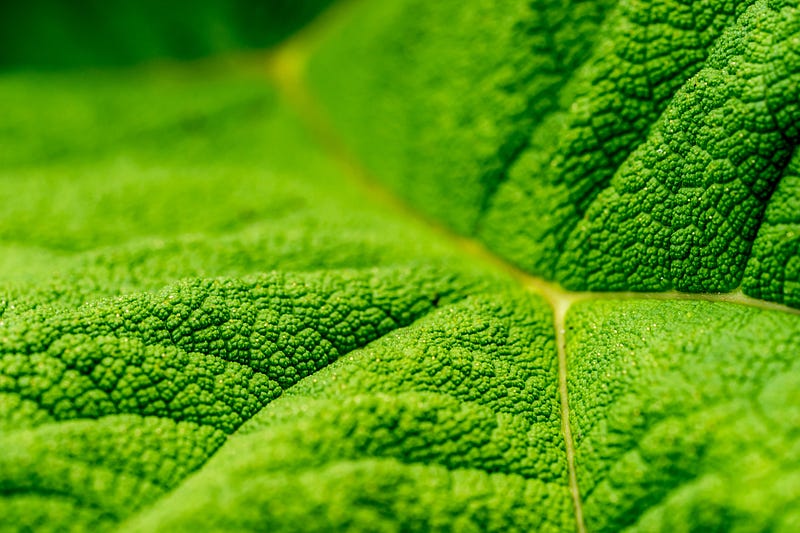The Marvel of Photosynthesis: Nature's Alchemical Process
Written on
Chapter 1: The Wonders of Photosynthesis
The process of photosynthesis is nothing short of remarkable. It’s a vital mechanism that sustains life as we know it.

Photo by Stefan Steinbauer on Unsplash
My passion for plants began about two years ago, primarily after I stumbled upon succulents—ideal for beginners due to their low maintenance needs. Since then, my understanding of plant care has evolved tremendously, and I’ve amassed quite the collection. The more I delve into the subject, the more intrigued I become, especially when it comes to the process of photosynthesis, which is fundamental to plant life. Although we learn about it in school, how often do we truly ponder its significance?
Section 1.1: Understanding Photosynthesis
At its core, photosynthesis is how plants generate oxygen. However, the intricate details of how plants and other autotrophs achieve this, and the subsequent effects, are where the true wonder lies.
For clarification, autotrophs are organisms that synthesize their food from inorganic materials using light or heat. This group includes not only plants but also algae, fungi, and some bacteria. While most autotrophs engage in photosynthesis, not all do.
The photosynthesis process relies on three key ingredients: water (H2O), carbon dioxide (CO2), and sunlight. Initially, I believed sunlight and water served as food for plants, but I soon realized they function more as essential components. Plants utilize these elements to produce glucose, a type of sugar that acts as their food source. My curiosity led me to explore how this transformation occurs.
I came across a detailed resource from the Smithsonian, which explained that tiny openings in a plant's leaves, branches, stems, roots, and flowers allow carbon dioxide to enter. Similarly, plants absorb water—though the amount varies significantly among species. Some thrive in water, while others, like succulents and cacti, require minimal moisture. Typically, plants utilize their roots to gather water but can also absorb it through their leaves, especially in humid environments.
Once a plant has taken in sufficient water and carbon dioxide, it harnesses sunlight's energy to convert these elements into glucose, akin to an alchemical transformation. Sunlight and heat instigate a chemical reaction that breaks down CO2 and H2O molecules, ultimately rearranging them into glucose and oxygen.
After producing glucose, a plant's mitochondria convert it into energy for growth and healing. The excess oxygen, which is a byproduct of this process, is released back into the atmosphere through the same openings used for carbon dioxide intake.
As if that isn’t impressive enough, there’s more to discover.
Section 1.2: The Intricacies of Chloroplasts
Within plant cells, tiny structures known as chloroplasts serve as energy storage units, akin to small batteries. Inside these chloroplasts, chlorophyll absorbs specific light wavelengths, primarily blue and red, while reflecting green—this is why plants appear green.
While there are additional stages and types of photosynthesis, such as light-dependent and light-independent reactions, as well as C3 and C4 photosynthesis, I won't delve too deeply into them here. For those interested, I recommend checking out a National Geographic resource for further exploration.
Even without understanding every facet, the phenomenon of photosynthesis is truly breathtaking. To summarize, without this process, life as we know it wouldn’t exist—no humans, no animals, no plants. We rely on plants not only as a food source but also for the oxygen they produce.
Chapter 2: The Broader Impact of Photosynthesis
In the first video titled "Photosynthesis is WAY Crazier than You Think!" viewers will uncover the astonishing complexities of photosynthesis and its essential role in life on Earth.
Additionally, plants act as energy reservoirs, storing solar energy. Herbivores consume plants, thus indirectly accessing solar energy, while carnivores, in turn, consume herbivores. This intricate web of energy transfer means that we, too, are interconnected as living batteries, all deriving energy from the sun. Isn't it fascinating to think of our planet as one massive battery filled with countless smaller batteries, each containing the sun's energy?
Moreover, plants have the fascinating ability to propagate. A single plant can clone itself, showcasing one of the most intriguing aspects of plant biology. With the escalating threat of global warming, it’s crucial to remember that plants absorb carbon dioxide and produce oxygen through photosynthesis, underscoring the importance of this process for our future and that of generations to come.
Section 2.1: A Shift in Perspective
As an avid nature enthusiast, my childhood was filled with climbing trees and playing outdoors. I was fortunate to attend an environmentally focused school, where I learned about native plants, their edibility, and basic medicinal properties.
However, I never grasped the biology behind how plants functioned until recently. Perhaps my earlier education lacked engagement, or I simply wasn’t interested at the time. Now, as an adult, I find myself in awe of the extraordinary role plants play—not only in my life but in the existence of all living beings on Earth. We owe our very survival to them.
This article was initially published in the author's free newsletter, Curious Adventure, and has been edited and republished on Medium with her permission.
Subscribing to any option grants access to Katrina’s articles and an archive of two years’ worth of content available 24/7. Subscription fees support Katrina in her endeavor to continue exploring her curiosities and sharing them with you.
Thank you for reading; your support is greatly appreciated.
In the second video titled "Good Thinking! — Photosynthesis: Blinded by the Light," viewers will gain insight into the intricate details of photosynthesis, enhancing their understanding of this vital process.